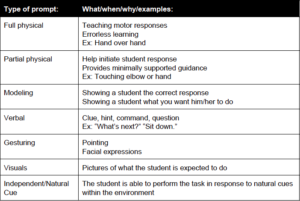Prompting
What and Why:
A Prompting Hierarchy provides teaching staff with a systematic approach to teaching students to use and learn new skills. It also provides teachers a framework for communicating about a student’s level of independence. It is important to keep in mind the least intrusive vs. the most intrusive way we are prompting/cueing students.
Materials:
- Materials will vary depending on the skills that are being taught.
How and When to Implement:
- Implement when the student is expected to complete a new skill or a skill that is difficult for them to complete independently.
Things to Consider/Problem Solving:
- Modeling is a great first step in teaching students new skills.
- Remember that verbal prompts are very difficult to fade, so they should be used sparingly.
- Remember to provide wait time after an initial direction is given before prompting a student.
- Make sure all adults working with the student know the current level of prompting for a skill so no one is over or under prompting the student.
- It’s helpful to create a structured plan that identifies what type of prompt to use first when cueing a student, what it looks like/sounds like (e.g. pointing, saying, “what’s next”), how long to wait before cueing again and identify what level of prompt to move to when the student is unresponsive.
- If a student is inconsistent with a skill when performed for different adults it is important to look at the levels of prompting each is using and if there is any unintentional prompting.
Useful Resources to Learn More:
This site provides an example of structured plan in teaching a student a skill. http://www.unr.edu/ndsip/tipsheets/UsingLeasttoMostPrompts.pdf
Click to return to Best Practices for Supporting Students with Autism
Information compiled by Lincoln Public Schools Autism Team (September 2015)


